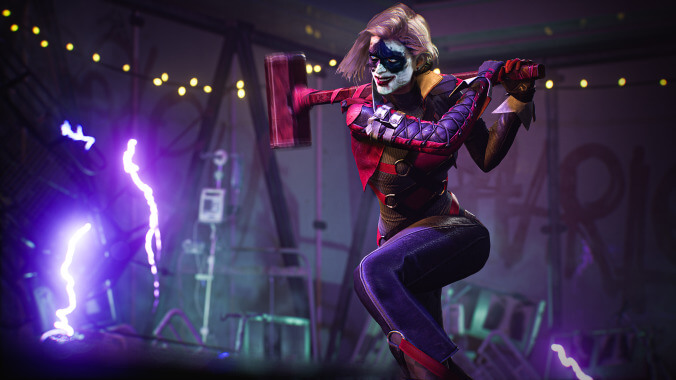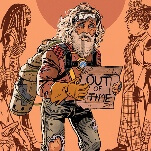Image: Warner Bros. Interactive Entertainment
It’s been seven years since the release of Batman: Arkham Knight, the final installment in Warner Bros. Interactive Entertainment’s shockingly good Arkham franchise of Batman-based video games. I mention this fact both because it’s always good to be reminded of the grim and relentless passage of time—but also because that fact, the sheer gulf of years between now and the release of the last pretty good Batman game, is the single greatest selling point that WBIE’s new offering, Gotham Knights, has to its credit. Certainly, the game itself struggles to make a more compelling case.
Developed by WB Games Montréal—whose last foray into Gotham City was 2013's lackluster prequel Batman: Arkham Origins—Gotham Knights isn’t actually a sequel to the Arkham games at all. Instead, it takes place in a slightly tweaked version of Bat History, albeit one familiar to even passing fans of nearly a century of Bat-Lore: Bruce Wayne is still The Batman, he’s still got a butler, and he’s still got a knack for recruiting teenagers and twentysomethings with a taste for high-impact acrobatics and nocturnal crime-fighting. The only real difference between this Bruce, and the one you might be more familiar with, is that this one is dead—slain in the game’s opening cutscene by one of his classic foes.
It’s a decent enough hook for a Batman story, as Wayne’s four surrogate children—Barbara “Batgirl” Gordon, Dick “Nightwing” Grayson, Jason “Red Hood” Todd, and Tim “Robin” Drake—come together to untangle both their grief, and the mess that their formidable Bat-Dad has left in his wake, a sprawling mystery that encompasses both the standard rogues gallery of baddies, plus an enigmatic secret society known as the Court Of Owls. (Lifted, pretty much wholesale, from Scott Snyder and Greg Capullo’s Batman comics from the early 2010s.) Choosing one of the four heroes (with the option to switch out periodically), players dive into the Gotham, uh, nights, hoping to honor their slain mentor’s legacy and bring the forces that killed him to justice.
Despite that big, fancy shift in continuity, though, players of Gotham Knights will still find themselves doing a lot of things that will be very familiar to anyone who spent much time with any of the latter Arkham games, and Origins especially. To wit, expect to spend hour upon hour beating up crooks, grapple-hooking your way across Gotham—and wondering why you’re not just playing 2011's Batman: Arkham City again, instead. That last point is, perhaps, unkind, but not inaccurate: Rocksteady Studios’ masterpiece, which opened the focused gameplay of their own Arkham Asylum into a city-wide exploration of Batman’s skills and abilities, is clearly the template for much of what Gotham Knights sets out to do. Except, here’s the brutal truth: At almost every point where WB Games Montréal has tried to expand that decade-old blueprint, possibly chart some new ground for themselves with this high-profile new release, they’ve instead made choices that almost inevitably weaken the eventual structure.
Take, for instance, the game’s combat, which still carries many of the hallmarks of the original Arkham formula. There’s the fluidity of motion, which sends your Bat Hero of choice bounding across the battlefield. There’s the focus on multi-opponent melees, forcing you to use gadgets and special moves to control the momentum of the fight. There’s the emphasis on avoiding damage, engaging with a series of dodges and counter-moves to confer that precious hint of Bat-Invincibility. It’s all there (if feeling a little stiffer, and a little simpler, than in memory.) What’s also there, though, is a new series of RPG-style experience levels that have been bolted over the top of the whole apparatus, and which heavily impact the damage you both take from, and dish out to, enemies. The result is to create absurd situations in which, say, an “under-leveled” Nightwing can beat on a regular mook for a minute straight, without successfully knocking them out. (Enemy levels are generally set to grow alongside the player’s while out in Gotham proper, where you spend much of your time foiling procedurally generated crimes. Engage in a more formal mission that’s above your characters’ level, though, and expect the frustration to swiftly set in.)
As with many of Gotham Knights’ worst ideas, it’s not hard to squint and see the logic behind the choice. Whereas the Arkham games presented a Batman fully formed (give or take a few tweaks to the tech tree), Gotham Knights is a story about heroes on the rise. It makes sense, then, to chart their growth in a more formalized, and maybe even a more number-crunchy, way. But the end result is confused, and sometimes miserable; nothing craps up the basic power fantasy of a superhero game like watching a cape-clad hero dive across a room, fist-outstretched to lay out a gun-toting thug…only to have a paltry “20" damage float up above their head when the strike connects.
See also the game’s loot system, which elevates itself above the worst such offenders in superhero gaming—*cough* Marvel’s Avengers *cough*—mostly by not ever becoming actively burdensome. Instead of shoving loose Bat-Suits or bo staffs into their crime-fighting pajamas, players in Gotham Knights pick up crafting materials and blueprints in abundance, bringing them back to their home base, The Belfry, for later production. Again, there’s the core of a good idea here—the various suits and sticks allow you to customize your gear and prepare for future challenges, a very Batman thing to do. But they also encourage that same spirit of number-hunting (got to keep that Destiny-style “Power” rating up!) while also creating absurd situations in which, say, Batgirl goes out of her way, mid-saving-lives, so that so she can pilfer a chest full of loot that’s been tucked away down a random side corridor. (To the game’s credit, it also encourages exploration by sprinkling, with some frequency, discoverable snippets of lore and DC Comics in-jokes throughout its missions—a reward that’s easily a dozen times more motivating than popping the lid on your hundredth component-stuffed chest.)
And that’s Gotham Knights in a nutshell, really: Good ideas on paper that rarely, if ever, result in good experiences in practice. Want to glide across the expanded, massive version of Gotham with your cape, instead of firing your grapple every couple of seconds to bounce across the rooftops? Easy: Just complete a long-ish set of random fights (only as Batgirl, mind), go home to the Belfry for the night, watch a cutscene, and there you go: Basic movement commands unlocked. (The other three characters have their own specific movement upgrades to unlock; would it shock you to learn that they’re both cumbersome to acquire, and more complicated to play with than actually fun? It’s pretty much gothamknights.txt!) Want fast travel points? Sure: Just make your way through several hours of story, then individually unlock each one by hunting down hostile police drones floating around the map. It’s all like this: More characters, more points of friction, more stuff, all intended to enhance the still quite good base gameplay lurking underneath here, and all doing little more than getting in its way.
It is not, to be clear, all bad. The game’s writing and storytelling work more often than not—especially in the quieter moments that play heavily into its themes of found family and legacy. (The voice acting, not so much; the four main characters, and Alfred, are all basically fine, but Michael Antonakos’ take on Batman, who pops up regularly in flashbacks and recovered recordings, is one of the snooziest takes on The Dark Knight I’ve ever heard.) The driving, which puts you in the seat of the Bat-Cycle, is actually pretty damn fun, maybe the one place where Gotham Knights unambiguously triumphs over its semi-predecessors. The four characters all distinguish themselves play-wise at least a bit, with more differences cropping up the further into their skill trees you get. (Go with Batgirl, by the way, if you want the most traditional Arkham experience—although not even the gun-toting Red Hood is all that different in practice in the early game.) And while I wasn’t able to fully put the game’s online co-op through its paces ahead of release, I got enough of a taste to see that it actually, genuinely works: Two heroes running around a massive city in tandem, teaming up (or not!) to take down the bad guys together.
And that might, honestly, be enough. I often found myself frustrated, in the 40 hours or so I’ve spent with it, with the decisions that Gotham Knights makes. (Really, WB Games Montréal? You’re going to bring out not just one, but two boss battles with Mister Freeze—whose Arkham City incarnation is still a regular on lists of “Best Boss Battles Of All Time”—and have them be such dull, Video Games 101 slogs?) But all these unforced errors are being applied to a framework that’s so solid that it’s still hard not to have fun with it for a decent proportion of the time. The worst thing you can say about the game, really, is that in reviewing it, I’ve been unable to avoid mentioning what’s ostensibly a whole separate series of video games in pretty much every paragraph. That’s how beholden the good in Gotham Knights is to Rocksteady’s work—but that good is still present, nevertheless.
Besides: It’s been seven damn years since Arkham Knight came out. I gotta get my Bat-Fix somehow.









































